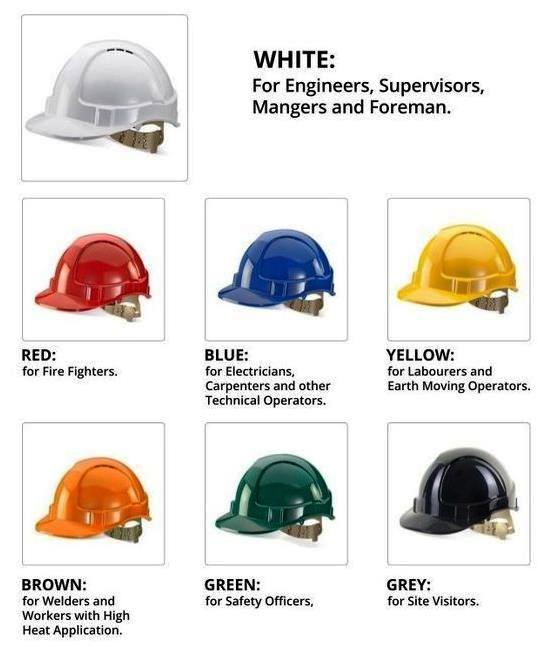Safety helmets are essential personal protective equipment (PPE) that provide vital head protection in various industries and workplaces. They are designed to prevent or minimize the risk of head injuries caused by falling objects, impacts, or electrical hazards. To ensure proper identification and compliance with safety standards, safety helmets are color-coded according to the guidelines provided by the Occupational Safety and Health Administration (OSHA). In this article, we will explore the standard color codes for safety helmets as mandated by OSHA, their significance, and their role in ensuring workplace safety.
Introduction
Safety helmets are crucial protective gear that plays a significant role in safeguarding workers from head injuries in various industries. The Occupational Safety and Health Administration (OSHA) provides guidelines and regulations to ensure the use of safety helmets and their standard color codes. This article aims to explore the importance of safety helmets, delve into OSHA guidelines, and discuss the standard color codes associated with safety helmets.
Importance of Safety Helmets
Safety helmets are essential personal protective equipment (PPE) in industries where there is a risk of head injuries from falling objects, impact hazards, or electrical shocks. They provide a protective barrier for the head, reducing the severity of injuries and saving lives. Wearing safety helmets is mandatory in many workplaces to ensure the well-being of employees and to comply with safety regulations.
OSHA Guidelines for Safety Helmets
OSHA, the regulatory body responsible for workplace safety in the United States, has established guidelines for safety helmets. These guidelines outline the requirements for helmet design, materials, and performance standards. OSHA enforces these guidelines to minimize the risk of head injuries and ensure the safety of workers in hazardous environments.
Standard Color Codes for Safety Helmets
Safety helmets are often distinguished by different colors, indicating specific roles or responsibilities in the workplace. The standard color codes help quickly identify workers and their functions, enhancing communication and safety protocols. Here are the most common safety helmet color codes:
Yellow Safety Helmets
Yellow safety helmets are typically worn by general laborers and construction workers. They signify caution and indicate that the wearer is involved in manual labor or site operations.
Red Safety Helmets
Red safety helmets are commonly worn by firefighters and emergency personnel. The red color signifies danger and is associated with firefighting and emergency response activities.
Blue Safety Helmets
Blue safety helmets are often used by technical workers or those involved in electrical-related tasks. The blue color helps differentiate workers who handle electrical systems or equipment, highlighting their expertise in this field.
Green Safety Helmets
Green safety helmets are usually worn by safety officers, inspectors, or supervisors. The green color denotes their authority and responsibility for monitoring safety practices and ensuring compliance on-site.
White Safety Helmets
White safety helmets are typically worn by engineers, architects, or site managers. The white color represents professionals involved in the planning, design, and overall management of construction projects.
Orange Safety Helmets
Orange safety helmets are commonly worn by road workers and personnel in high-visibility environments. The orange color enhances visibility and warns others of potential hazards on the road or work zone.
Gray Safety Helmets
Gray safety helmets are often associated with visitors or individuals who are not actively involved in construction or industrial operations. The gray color helps identify individuals who may have restricted access or limited involvement on-site.
Conclusion
Safety helmets with their standardized color codes are crucial elements of workplace safety. They protect workers from head injuries and improve overall safety protocols. Understanding the color codes associated with safety helmets ensures effective communication and easy identification of roles in various industries.
Get Access Now Free Safety Books: Health & Safety Books
FAQs
What are safety helmet standard color codes?
Safety helmet standard color codes are a set of predefined colors used to differentiate workers based on their roles or responsibilities in the workplace. Each color represents a specific function or job category, facilitating easy identification and enhancing overall safety.
Why is it important to wear a safety helmet?
Wearing a safety helmet is vital because it protects the head from potential injuries in hazardous environments. It acts as a barrier against falling objects, impact hazards, or electrical shocks, reducing the severity of injuries and potentially saving lives.
Are safety helmet color codes the same globally?
Safety helmet color codes can vary between countries and organizations. While some color codes might be consistent, it is important to consult specific regulations and guidelines within a particular region or industry to ensure accurate identification.
Can safety helmet color codes vary within an organization?
Yes, safety helmet color codes can vary within an organization based on their specific requirements and safety protocols. It is crucial for organizations to establish clear guidelines and communicate the color codes effectively to avoid confusion and promote workplace safety.
Where can I find more information about safety helmet standards?
For more detailed information about safety helmet standards, it is recommended to refer to OSHA regulations, and industry-specific guidelines, or consult with safety experts and professionals who specialize in workplace safety. They can provide accurate and up-to-date information based on your specific industry and location.
 Boilersinfo Boiler and Mechanical Power Digital Library
Boilersinfo Boiler and Mechanical Power Digital Library






